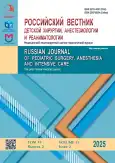睾丸女性化综合征的家族性病例:临床观察
- 作者: Al-Hares M.M.1,2, Tomaev V.Y.2, Mikhaylov G.A.2, Lisitsa I.A.1, Lisovsky O.V.1, Zavyalova A.N.1, Ivanov D.O.1
-
隶属关系:
- Saint Petersburg State Pediatric Medical University
- Filatov Children’s Hospital
- 期: 卷 15, 编号 2 (2025)
- 页面: 213-222
- 栏目: Case reports
- URL: https://journal-vniispk.ru/2219-4061/article/view/313003
- DOI: https://doi.org/10.17816/psaic1864
- EDN: https://elibrary.ru/TBEBLT
- ID: 313003
如何引用文章
详细
激素调控在人类性发育过程中起着关键作用。雄激素受体基因的突变可导致外周雄激素不敏感性,从而影响患者的表型特征。在完全雄激素不敏感的情况下,由于睾酮被芳香化为雌激素,患者虽存在性发育障碍,但表现为女性表型。患者的典型主诉之一是腹股沟区双侧疝样膨出,常被误诊为腹股沟疝。行睾丸切除术可能导致骨矿代谢紊乱和一定程度的男性化改变;另一方面,随着年龄增长,恶性变的风险亦随之升高。本文报告一例家族性睾丸女性化综合征,在两名分别为14岁和6岁的女孩中发现了首次报道的AR基因突变(NM_001011645.3)。两名女孩因自出生起双侧腹股沟疝入院接受择期手术。术中行疝修补时发现睾丸结构,并进行活检:一例证实为睾丸组织,另一例为白膜组织。根据术中获得的资料,进一步开展了评估,包括泌尿生殖系统的超声检查、激素水平评估和医学遗传学检测,并由内分泌科医生和遗传科医生进行会诊。两例均确诊为睾丸女性化综合征(在AR基因第7外显子中检测到变异HG38, chrX:67721856T> C,即c.746T> C,处于半合子状态,导致氨基酸置换p.Met249Thr)。对其母亲进行DNA测序发现存在AR基因突变,呈杂合状态。对患儿父亲、姐姐及哥哥的基因检测未发现病理性变异。经家属同意,两名患儿均接受了双侧腹腔镜下睾丸切除术。本研究表明,年龄在手术干预时机的选择中具有重要意义,尤其是在性发育和表型形成方面。此外,文章还论证了采取多学科综合诊疗模式以解决患者功能、社会和性别相关问题的必要性。
作者简介
Milad M. Al-Hares
Saint Petersburg State Pediatric Medical University; Filatov Children’s Hospital
Email: haresmilad@gmail.com
ORCID iD: 0000-0002-4765-5421
SPIN 代码: 3485-1655
俄罗斯联邦, Saint Petersburg; Saint Petersburg
Vadim Yu. Tomaev
Filatov Children’s Hospital
Email: hirurg.tomaev@mail.ru
ORCID iD: 0009-0004-4228-5849
俄罗斯联邦, Saint Petersburg
Gleb A. Mikhaylov
Filatov Children’s Hospital
Email: mihailov.g@db5.ru
ORCID iD: 0000-0001-9073-6975
俄罗斯联邦, Saint Petersburg
Ivan A. Lisitsa
Saint Petersburg State Pediatric Medical University
编辑信件的主要联系方式.
Email: ivan_lisitsa@mail.ru
ORCID iD: 0000-0003-3501-9660
SPIN 代码: 4937-7071
俄罗斯联邦, Saint Petersburg
Oleg V. Lisovsky
Saint Petersburg State Pediatric Medical University
Email: oleg.lisowsky@yandex.ru
ORCID iD: 0000-0002-1749-169X
SPIN 代码: 7510-5554
MD, Cand. Sci. (Medicine)
俄罗斯联邦, Saint PetersburgAnna N. Zavyalova
Saint Petersburg State Pediatric Medical University
Email: anzavjalova@mail.ru
ORCID iD: 0000-0002-9532-9698
SPIN 代码: 3817-8267
MD, Dr. Sci. (Medicine)
俄罗斯联邦, Saint PetersburgDmitry O. Ivanov
Saint Petersburg State Pediatric Medical University
Email: spb@gpma.ru
ORCID iD: 0000-0002-0060-4168
SPIN 代码: 4437-9626
MD, Dr. Sci. (Medicine)
俄罗斯联邦, Saint Petersburg参考
- Liu Q, Yin X, Li P. Clinical, hormonal and genetic characteristics of androgen insensitivity syndrome in 39 Chinese patients. Reprod Biol Endocrinol. 2020;18(1):34. doi: 10.1186/s12958-020-00593-0
- Lanciotti L, Cofini M, Leonardi A, et al. Different clinical presentations and management in complete androgen insensitivity syndrome (CAIS). Int J Environ Res Public Health. 2019;16(7):1268. doi: 10.3390/ijerph16071268
- Batista RL, Costa EMF, Rodrigues AS, et al. Androgen insensitivity syndrome: a review. Arch Endocrinol Metab. 2018;62(2):227–235. doi: 10.20945/2359-3997000000031
- Kumar A, Sharma R, Faruq M, et al. Clinical, biochemical, and molecular characterization of Indian children with clinically suspected androgen insensitivity syndrome. Sex Dev. 2022;16(1):34–45. doi: 10.1159/000519047
- Akcay T, Fernandez-Cancio M, Turan S, et al. AR and SRD5A2 gene mutations in a series of 51 Turkish 46,XY DSD children with a clinical diagnosis of androgen insensitivity. Andrology. 2014;2(4):572–578. doi: 10.1111/j.2047-2927.2014.00215.x
- Acién P, Acién M. Disorders of sex development: Classification, review, and impact on fertility. J Clin Med. 2020;9(11):3555. doi: 10.3390/jcm9113555
- Damirov MM, Anchabadze IV, Medvedev AA, Eremenko MA. Clinical case of the complete form of androgen insensitivity syndrome (AIS). Russian Sklifosovsky Journal “Emergency Medical Care”. 2023;12(2):327–332. doi: 10.23934/2223-9022-2023-12-2-327-332 EDN: KNSDWM
- Zheng GY, Chu GM, Li PP, He R. Phenotype and genetic characteristics in 20 Chinese patients with 46,XY disorders of sex development. J Endocrinol Invest. 2023;46(8):1613–1622. doi: 10.1007/s40618-023-02020-8
- Shrestha A, Thapa A, Bohara K, Simkhada S. Complete androgen insensitivity syndrome diagnosed after inguinal surgery in era of modern technology: a case report. Ann Med Surg (Lond). 2023;86(1):548–551. doi: 10.1097/MS9.0000000000001521
- Tayts AN, Belozerov KE, Guslistova AV, Omelchuk KL. Tactics of androgen resistance syndrome management in the Russian Federation and a modern view of the problems of gender differentiation disorder. Pediatria n.a. G.N. Speransky. 2020;99(2):83–87. doi: 10.24110/0031-403X-2020-99-3-83-87 EDN: QDJMDO
- Morris JM. The syndrome of testicular feminization in male pseudohermaphrodites. Am J Obstet Gynecol. 1953;65(6):1192–1211. doi: 10.1016/0002-9378(53)90359-7
- Adamyan LV, Sibirskaya EV, Sharkov SM, et al. Difficulties in diagnosing disorders of sexual development. Russian Journal of Pediatric Surgery. 2019;23(1):44–47. doi: 10.18821/1560-9510-2019-23-1-44-47 EDN: YZRXXV
- Kristesashvili J, Kobaladze L, Chipashvili M, Jibladze A. Sex assignment and psychosexual peculiarities of individuals with different forms of androgen insensitivity syndrome: A qualitative study. Int J Reprod Biomed. 2024;21(12):985–994. doi: 10.18502/ijrm.v21i12.15036
- Hughes IA, Davies JD, Bunch TI, et al. Androgen insensitivity syndrome. Lancet. 2012;380(9851):1419–1428. doi: 10.1016/S0140-6736(12)60071-3
- Starostina EA, Frolkova NV, Seidova SM, et al. Androgen insensitivity syndrome: preventive gonadectomy, pros and cons. Obesity and metabolism. 2024;21(1):85–91. doi: 10.14341/omet13024 EDN: OZRFUU
- Galani A, Kitsiou-Tzeli S, Sofokleous C, et al. Androgen insensitivity syndrome: clinical features and molecular defects. Hormones (Athens). 2008;7(3):217–229. doi: 10.14310/horm.2002.1201
- Matalka L, Dean SJ, Beauchamp G, Sunil B. An early case of complete androgen insensitivity syndrome. J Investig Med High Impact Case Rep. 2023;11:23247096231157918. doi: 10.1177/23247096231157918
- Farah S, El Masri D, Hirbli K. Complete androgen insensitivity syndrome in a 13-year-old Lebanese child, reared as female, with bilateral inguinal hernia: a case report. J Med Case Rep. 2021;15(1):202. doi: 10.1186/s13256-021-02738-0
- Gallardo-Durán KG, De la Fuente-Cortez BE, Villarreal-Benavides TC, Garcia-Vielma C. Complete androgen insensitivity syndrome: diagnosis and multidisciplinary management. Rev Med Inst Mex Seguro Soc. 2023;61(1):117–122. (In Spanish)
- Gavrilyuk VP, Kostin SV, Statina MI, et al. Syndrome of complete insensitivity to androgens of the 4-years-old child. Russian Journal of Pediatric Surgery, Anesthesia and Intensive Care. 2020;10(1):89–94. doi: 10.17816/psaic566 EDN: UBGMQI
- Cools M, Wolffenbuttel KP, Hersmus R, et al. Malignant testicular germ cell tumors in postpubertal individuals with androgen insensitivity: prevalence, pathology and relevance of single nucleotide polymorphism-based susceptibility profiling. Hum Reprod. 2017;32(12):2561–2573. doi: 10.1093/humrep/dex300
- Cools M, Drop SL, Wolffenbuttel KP, et al. Germ cell tumors in the intersex gonad: old paths, new directions, moving frontiers. Endocr Rev. 2006;27(5):468–484. doi: 10.1210/er.2006-0005
- Hannema SE, Scott IS, Rajpert-De Meyts E, et al. Testicular development in the complete androgen insensitivity syndrome. J Pathol. 2006;208(4):518–527. doi: 10.1002/path.1890
- Weidler EM, Linnaus ME, Baratz AB, et al. A management protocol for gonad preservation in patients with androgen insensitivity syndrome. J Pediatr Adolesc Gynecol. 2019;32(6):605–611. doi: 10.1016/j.jpag.2019.06.005
补充文件









